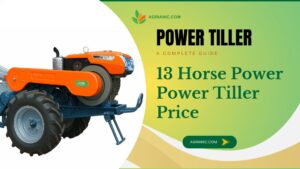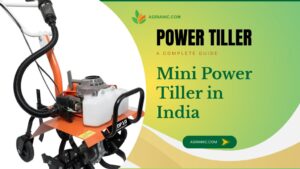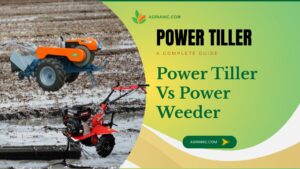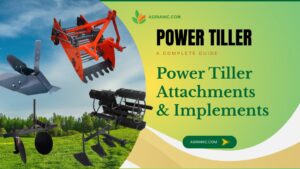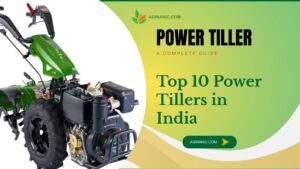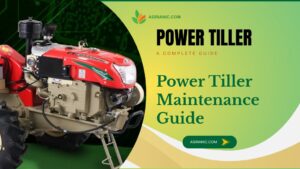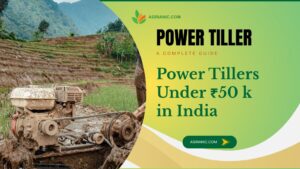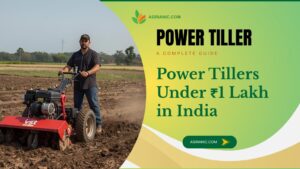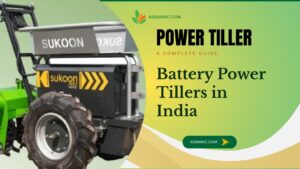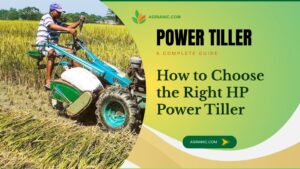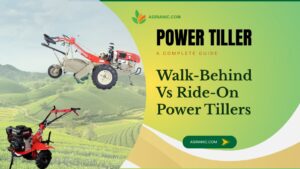Power Tiller in India: Complete Guide (Uses, Prices, Brands 2025)
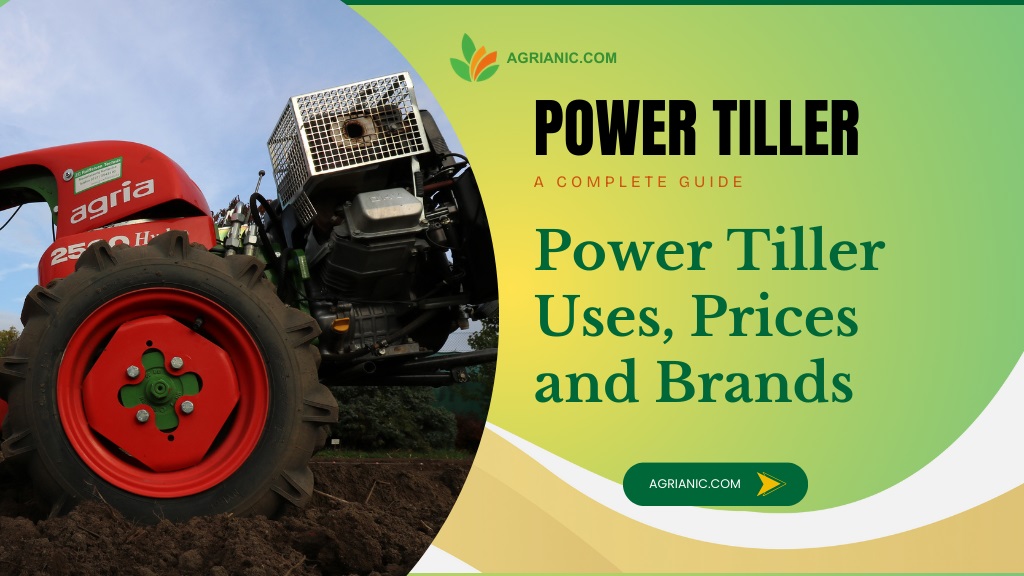
Mechanising farming is no longer a luxury – it’s a necessity. With shrinking land holdings and rising labour costs, many small and medium Indian farmers are turning to power tillers as a cost-effective alternative to large tractors. This guide explains what a power tiller is, how farmers use it, the price ranges in 2025, popular brands, subsidy information, and practical buying and maintenance tips.
If you’ve ever wondered whether a power tiller is right for your farm, this article will walk you through the real-world uses, how to choose the correct horsepower, what you can expect to pay, and how to keep the machine running for years. At the end, there are practical FAQs that answer common farmer questions.
What is a Power Tiller?
A power tiller is a two-wheeled, walking tractor used for soil preparation, puddling, ridging, weeding, and light transport. It sits between manual tools and a full-sized tractor: cheaper, more fuel-efficient, and easier to maintain. Power tillers are particularly useful for small to medium farms (roughly 1–10 acres) and areas where tractors are impractical.
Main Uses of Power Tillers
- Ploughing and Tilling – primary land preparation before sowing.
- Puddling – used in paddy fields for rice cultivation.
- Weeding and Inter-cultivation – with the right attachment, the tiller becomes a power weeder.
- Ridging and Furrowing – for root crops like potatoes and onions.
- Sowing and Seed Drilling – certain attachments enable seeding operations.
- Transport – fitted with a small trailer, it can carry 300–500 kg for local transport.
Types of Power Tillers (by Horsepower)
Power tillers are commonly classified by horsepower (HP). Choose the class that matches your land, soil, and crop pattern.
- Mini Power Tillers (5–8 HP) – best for kitchen gardens and very small farms.
- Small Power Tillers (8–12 HP) – suitable for farms up to about 3–4 acres.
- Medium Power Tillers (12–15 HP) – the most popular category for mixed farms and paddy fields.
- Heavy Power Tillers (15–20 HP) – for larger holdings, cooperative farming, or commercial use.
Power Tiller Price in India (2025) – Typical Ranges
Prices vary by HP, brand, attachments, and state (transport and dealer margins). The table below gives typical price ranges you can expect in 2025.
| Category | HP Range | Typical Price Range (₹) |
|---|---|---|
| Mini Power Tiller | 5–8 HP | ₹60,000 – ₹1,20,000 |
| Small Power Tiller | 8–12 HP | ₹1,20,000 – ₹1,80,000 |
| Medium Power Tiller | 12–15 HP | ₹1,80,000 – ₹2,50,000 |
| Heavy Power Tiller | 15–20 HP | ₹2,50,000 – ₹3,50,000 |
Quick note: final on-road price may differ. Always check local dealer quotes and factor in any available subsidy or state-specific support.
Popular Power Tiller Brands in India
Some brands are preferred because of durability, parts availability, and after-sales service. Popular choices include:
-
- VST Tillers Tractors Ltd. – durable machines and a strong dealer network in many states.
- KAMCO (Kerala Agro Machinery Corporation) – widely used in southern states and for paddy.
- Kubota – Japanese technology and reliability; often priced higher but long-lasting.
- Greaves Cotton – competitive pricing and service reach.
- Honda – Known for compact and reliable mini tillers, best for kitchen gardens and very small farms.
- Shrachi – Offers affordable mini tillers and small-farm solutions with good dealer availability in eastern India.
Government Subsidies & Support (What Farmers Should Know)
State and central schemes often provide subsidies to promote farm mechanization. Typical subsidy patterns observed across schemes are:
- Subsidy percentages commonly range from 40% to 50% for small and marginal farmers.
- In some states and special categories (women farmers, SC/ST beneficiaries), subsidies can be higher – sometimes up to 60%.
- Eligibility, required documents, and application processes vary by state and scheme year – always confirm details with your district agriculture office or local extension centre.
How to Choose the Right Power Tiller for Your Farm
Match the machine to your reality. Here are practical selection criteria:
- Farm size: mini tiller for under 2 acres, medium tillers for 3–7 acres, heavy tillers for larger land or multiple users.
- Soil type: heavier clay and wet soils require more HP and robust tines; sandy soils need less power.
- Crop pattern: rice growers need puddling attachments; vegetable growers typically use weeding and ridging implements.
- Attachments: ensure the model supports the implements you need (weeder, ridger, trailer, seed drill).
- Service network: pick brands with local dealers and spare parts availability to reduce downtime.
- Budget after subsidy: calculate the cost after expected subsidy so you know the out-of-pocket amount.
Practical Maintenance Tips
Simple, regular maintenance extends life and saves money:
- Clean the machine after each use and remove mud and crop residue.
- Lubricate moving parts and check gearbox oil at regular intervals.
- Inspect tines/blades for wear and replace when performance drops.
- Follow the manufacturer’s schedule for engine oil changes and filter replacements.
- Store the tiller under shade to protect against rust and sun damage.
A well-maintained power tiller can easily serve 8–10 years, depending on usage intensity and local support for spare parts.
Example Use Cases – Real Farmer Scenarios
Here are three short scenarios to show how different farmers might choose a machine:
- Vegetable Farmer (2 acres): chooses an 8–10 HP mini/small tiller with ridger and weeder attachments for repeated inter-cultivation.
- Paddy Farmer (5 acres): opts for a 12–15 HP medium tiller with puddling and trailer attachments for transport and seedbed prep.
- Co-op Group (15 acres collective): buys a 15–18 HP heavy tiller shared among members with multiple implements and a scheduled maintenance plan.
Power tillers offer a practical, affordable path to mechanization for many Indian farms. They reduce labour dependency, lower fuel costs compared to tractors, and increase farm productivity when matched correctly to farm size, soil, and crops. Use this guide to shortlist models, estimate the budget after subsidy, and prepare questions for your local dealer.
Ready to browse models and contact dealers? Visit our Power Tiller listings to view current models and send enquiries to trusted sellers across India.
Frequently Asked Questions (FAQs)
Which power tiller brand is best in India?
There is no single “best” brand; it depends on local service, spare parts availability, and the specific model. VST, Kubota, and KAMCO are well-regarded in various regions.
What is the average price of a 13 HP power tiller in 2025?
Expect roughly ₹1.8–2.2 lakh depending on brand, attachment,s and state-level pricing differences.
Can a power tiller replace a tractor?
For small farms (roughly 1–7 acres), a power tiller can replace many tractor functions. For very large farms or heavy draught work, a tractor remains the better option.
How much subsidy can I get for a power tiller?
Subsidies commonly range from 40% to 50% for eligible small and marginal farmers, with higher rates possible for specific beneficiary groups in certain states. Confirm with your district agriculture office.
How often should I service a power tiller?
Follow the manufacturer’s service schedule – typically basic checks after every 25–50 hours of operation and more extensive service at 100–200 hour intervals. Regular checks between service intervals are important.
Note: Prices and subsidy details change by state and scheme year. Always verify local dealer prices and government scheme conditions before purchase.
Get Prices from Verified Power Tiller Sellers Near You
We connect you with trusted and verified sellers near you. Get the best deals, fast and hassle-free!
Popular Products from Verified Sellers
No products found for this category.

